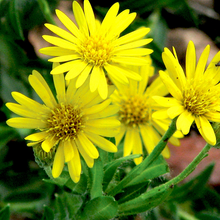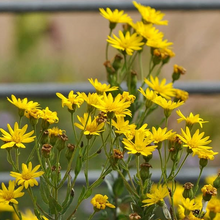Chrysopsis mariana, commonly known as Maryland golden aster, is a short lived perennial with golden yellow daisy like flowers that bloom in late summer and fall. Its soft silvery green foliage forms basal rosettes in the first year before sending up hairy flowering stems in the second. It readily self seeds in open soils and disturbed areas, making it a resilient presence in meadow style gardens or naturalized plantings. Its upright unbranched stems and bright flowers create vertical color late in the season when many other natives have faded.
Height & Spread: 12 - 24 in x 12 - 18 in
Bloom Time: Late summer to fall
Light Requirements: Full sun
Soil Preference: Well drained sandy or rocky soils
Watering Needs: Low; drought tolerant once established
Deer Resistance: Seldom browsed due to coarse foliage
Native Status
This species is native to the eastern and southeastern United States, commonly found in open woodlands, prairies, and coastal plains.
WILDLIFE & INSECTS
Butterflies
- Provides nectar for fall flying butterflies such as Painted Lady, Pearl Crescent, and Common Buckeye.
Bees
- Attracts a variety of native bees including sweat bees (Halictidae), leafcutter bees (Megachilidae), and bumblebees (Bombus spp.).
Moths
- Visited by nocturnal moths such as the Wavy Lined Emerald and various microlepidoptera for nighttime nectar feeding.
Birds
- Songbirds such as goldfinches and sparrows forage among dried seed heads and use the plant structure for cover.
Spacing & Landscape Use
Spacing Recommendations:
- Space 12 - 18 in apart to allow upright growth and encourage reseeding without crowding neighboring plants.
Landscape Placement:
- Excellent for naturalistic plantings, native meadows, restoration areas, or sunny slopes where late season bloom and self seeding are desirable.
Companion Plants
- Coreopsis verticillata 'Moonbeam' (Threadleaf Coreopsis) - Produces airy yellow blooms earlier in the season and forms a fine textured base for the upright golden aster.
- Symphyotrichum laeve (Smooth Blue Aster) - Adds height and contrasting blue flowers that bloom in sync with Chrysopsis.
- Monarda fistulosa (Wild Bergamot) - Offers aromatic foliage and pollinator value in summer, bridging seasonal bloom gaps.
- Asclepias tuberosa (Butterfly Weed) - Provides brilliant orange flowers and attracts butterflies during early and mid summer.
- Erigeron pulchellus (Robin's Plantain) - Offers early spring blooms and semi evergreen rosettes that contrast with golden aster’s vertical form.



